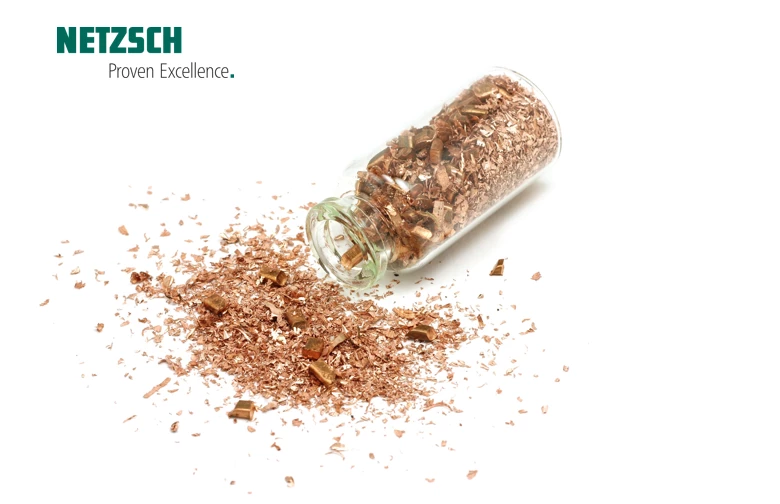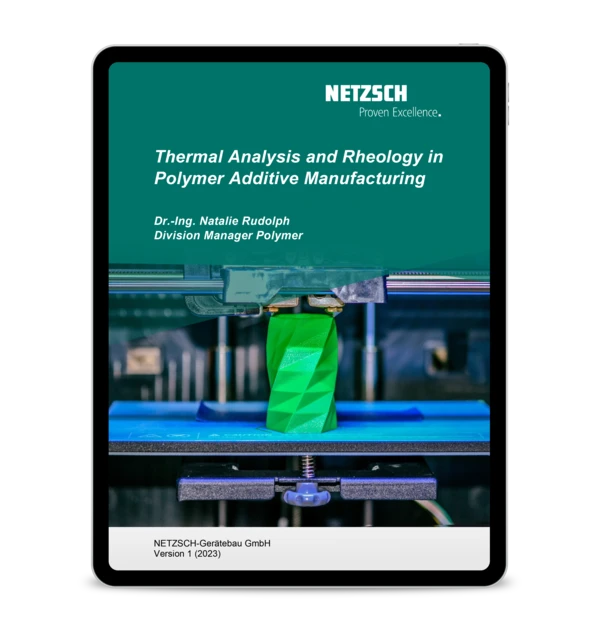
17.05.2021 von Dr. Natalie Rudolph, Dr. Stefan Schmölzer
How Fillers Affect the Crystallization Behavior of SLS Powders
Due to the still limited number of available materials for the Selective Laser Sintering process, there is a constant demand for materials with different properties. The addition of any filler to SLS powder typically has an effect on the processing behavior. Today, we investigate the crystallization behavior of PA12 powder filled with copper spheres and flakes.
One demand could be higher ductility (e.g., PA11), others could be better dimensional stability (e.g., addition of glass beads), higher electrical or thermal conductivity (e.g., fillers such as aluminum or copper) or increased stiffness and strength (e.g., addition of glass or carbon fibers).
Fillers act as nucleation sites
The addition of any filler to SLS powder typically has an effect on the crystallization behavior as the surfaces of the fillers act as heterogeneous nucleation sites. Conductive fillers can also affect the material temperature and therefore, show additionally changed behavior. Dynamic Differential Scanning Calorimetry (DSC) measurements can provide a first indication of a changed behavior, which can then be further analyzed through isothermal measurements at or close to the build temperature.
Adding conductive copper fillers
To understand the effect of conductive fillers, researchers at the Institute of Polymer Technology (LKT) at the University of Erlangen-Nuremburg experimented with copper fillers [1]. They used different mixtures of copper spheres and flakes (Figure 1) in varying contents and analyzed the processing behavior as well as the resulting conductive properties with the aim to generate complex components for thermal management. A variety of samples were prepared by adding copper spheres in 5 and 10 vol% and copper flakes at 5 vol% to the PA12 powder. The energy density of 0.043 J/mm2 was kept constant for all materials to detect any changes in the process behavior due to the fillers.

Determining the process window and crystallization behavior of PA12 powder with copper particles
At NETZSCH Analyzing & Testing, a DSC 214 Polyma was used to analyze the process window and the crystallization behavior of these different mixtures of PA12 powder with copper particles in comparison to the neat PA12 material.
For each measurement, a sample of 5 mg was cut and placed into an aluminum pan with concave bottom (Concavus® Al) and closed lid. The sample was cooled from room temperature to start the measurement at -20°C. It was then heated to 200°C at a heating rate of 10 K/min and cooled down at the same cooling rate of 10 K/min to -20°C.
The following table summarizes the measurement conditions.
Table 1: Measurement conditions
| Pan | Concavus® Al, closed lid |
| Sample weight | 5 mg |
| Atmosphere | N2 |
| Temperature range | -20°C to 200°C at a heating and cooling rate of 10 K/min |
The results for the neat PA12 were discussed in detail in this previous blogpost!
Changes in crystallization behavior
In Figure 2, the results of the 1st heating and cooling are depicted for all 4 samples. As can be seen, the peak melting temperature is not affected by the addition of the fillers (The difference in area is related to the varying filler contents and was not normalized in this graph).

However, it can be seen that the peak crystallization temperature as well as the onset of crystallization are shifted to higher temperatures with increasing filler content.
The peak is shifted from 145.8°C for the neat material to 149.1°C for 5 vol% copper fillers and to 151.3°C for 10 vol%, respectively.
It can be concluded that the fillers act as nucleation sites and accelerate crystallization. This leads to a slightly reduced process window and needs to be taken into account during the selection of the processing conditions.
A similar effect was observed by the WILO SE, a premium provider of pumps and pump systems, for glass and carbon fibers. Read the case study here!
Getting a better understanding of the crystallization behavior
Additional studies of the isothermal crystallization behavior can be useful to understand this behavior even better. A detailed description of the measurement procedure is given here for unfilled PA12 powder.
The researchers at LKT performed these additional isothermal studies at 165°C on the copper filled samples and found that the crystallization half time is reduced due to the addition of fillers, further confirming the nucleation effect. The whole study can be found here [Open Access]!
About the Institute of Polymer Technology (LKT)
The Institute of Polymer Technology is an academic research institute at the Friedrich-Alexander University of Erlangen-Nuremberg. It is one of the leaders in Additive Manufacturing research; particularly SLS. Other main research areas include Lightweight Design and FRP, Materials and Processing, Joining Technology and Tribology. In addition to these research focuses, the institute is also working on cross-disciplinary topics such as Filler Material Compounding, Simulation of Processing and Applications, Radiation Cross-linked Thermoplastics, Gentle Processing and many more.
Sources
[1] Lanzl, L., Wudy, K., Greiner, S., Drummer D., Selective Laser Sintering of Copper Filled Polyamide 12: Characterization of Powder Properties and Process Behavior, Polymer Composites, pp. 1801-1809, 2019.

FREE E-Book
Thermal Analysis and Rheology in Polymer Additive Manufacturing
Discover the secrets behind AM's game-changing capabilities! Our newly released ebook delves deep into the heart of AM, unveiling the power of reliable material characterization techniques, specifically thermal analysis and rheology.